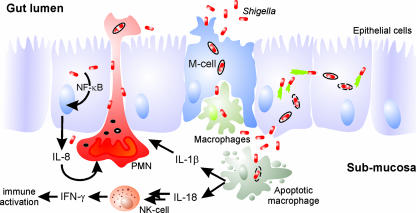FIG. 1.
Cellular pathogenesis of Shigella spp. S. flexneri passes the EC barrier by transcytosis through M cells and encounters resident macrophages. The bacteria evade degradation in macrophages by inducing an apoptosis-like cell death, which is accompanied by proinflammatory signaling. Free bacteria invade the EC from the basolateral side, move into the cytoplasm by vectorial actin polymerization, and spread to adjacent cells. Proinflammatory signaling by macrophages and EC further activates the innate immune response involving NK cells and attracts PMN. The influx of PMN disintegrates the EC lining, which initially exacerbates the infection and tissue destruction by facilitating the invasion of more bacteria. Ultimately, PMN phagocytose and kill Shigella, thus contributing to the resolution of the infection.

